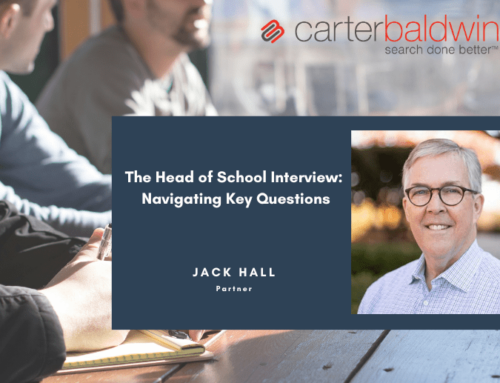When we conduct a search for an executive who will succeed in a leadership role with one of our clients we take into consideration what we believe to be the four critical components of a successful “fit.” These elements of fit include the skill set that the executive brings to the table, the cultural match with our client, the executive’s aspirations as they align with the role being filled and the trustworthiness (we call it “The Trust Factor”) of the executive under consideration.
Most of our clients and nearly the entire search industry concentrate their efforts on finding the right skill set, looking line by line on a resume to see if the candidate under consideration has completed tasks that would seemingly enable them to be familiar with the elements of the future role. During the interview, questioning may be nearly entirely focused upon resume issues, skills and the candidate’s previous behaviors that might predict future success. While a foundational skill set is keenly important, we believe that it is the most easily solvable piece of the success equation and often distracts interviewers from even more important considerations.
A second critical area of assessment is the area involving cultural fit. We believe that our culture is unique. We have never met a client who did not feel similarly about their own culture, and we are all correct in believing that our organizational cultures are unique. At CarterBaldwin, we have learned to measure culture in five key areas:
- Pace – the verbal, mental and physical pace at which an organization or an executive moves.
- Power – the structure that creates authority in an organization measured against how a selected executive values (and submits to) cultural power structures.
- Play – the social fit that makes working together a daily joy and resolves the minor differences in the other areas, or the obvious lack of social fit that exacerbates even the smallest conflicts.
- Push – the amount of resistance that an organization requires and will tolerate during times of change in comparison to an executive’s ability to engage in appropriate, necessary conflict.
- Principles – assesses flexibility versus rigidity, recognizing that an executive with a rigid principle framework will struggle in an organization with flexible principles and vice versa.
You can learn more about our work in the area of cultural match by downloading our whitepaper entitled Cultural Considerations In Hiring
Aspirational alignment is the third consideration when we are assessing a candidate. The candidate’s long term goals, not all of which are career oriented, must match the geography and the general trajectory of the role under consideration.
After culture fit, I have long believed that our fourth component of fit, what we call “the trust factor,” is the most important consideration in executive hiring. Not surprisingly then, it is also one of the most critical ingredients of an operationally functional leadership team… more important than knowledge, more important than corporate branding and even more important than talent.
While I am privileged to work with a team of highly talented people, it is the internal trust that we share that enables us to work so productively for our clients. On many occasions, I have shared with our team my belief that “there is a huge difference between 99% trust and 100% trust and that we must strive for 100% trust.” I wasn’t really sure that trust was actually measurable, until someone recently made it absolutely clear to me saying, “I’d trust him about as far as I can throw him.” Very interesting, I thought. I could throw him maybe 2 feet, not far…but it’s certainly measurable – and it explains why my trust in my own children began to diminish as they approached their teenage years.
Interestingly, there may not be anything in our lives that is more foundational to both business and personal relationships than trust and yet, for most of us, we have never really thought about what builds trust and what diminishes trust. It seems almost like that sixth sense – an intuition that either protects us or exposes our vulnerabilities. In actuality, there are elements of trust, “signals” that we will recognize as good indicators of trustworthiness and that we can then send in order to build trust in important relationships.
As we think about measuring trust, we must begin by understanding our baseline of trust, with people falling into two distinct camps. Some people (like me) begin a new relationship on a platform of trust and continue trusting until some occurrence or action causes them to lose trust, and eventually mistrust. Other people (like my wife) begin a relationship at a “zero basis,” not giving away trust until someone has given reason to believe that trust is warranted. In effect, some believe that trust must be earned, while others believe that trust may be given until distrust is earned. When these two people meet for the first time, both may be equally, trustworthy but connecting from diverse paradigms that may not be quickly able to trust each other – one because she does not trust without cause, and the other because the perceived lack of trust presents the first indication that an otherwise trustworthy person may not be as trustworthy as first perceived.
This is a true story…we received a call from an international company that asked us to conduct a search for their North American President. They flew in to meet with us and we began reviewing the criteria for their search. As we began to discuss the cultural aspects of fit, we talked about the principles component of our cultural assessment. The VP of HR, an American, told me very clearly that the company had a flexible set of principles, confiding in me that if the new President was not comfortable lying to customers and employees on occasion that success would be elusive. In fact, it was over that very issue that the previous president had come to an employment-ending conflict with the CEO. You can imagine our conundrum – we would be working diligently to align with our clients’ values to find a person that meets their culture, but how could we credibly search for a liar? If a candidate told us that lying was an acceptable business practice, could we believe them? I asked the VP of HR if we would have trouble collecting our fee from this international company and she assured me that we would not…but was she lying? Hmmm….we decided we could not accept this search.
The first signal in measuring trust comes from listening to what someone actually says about themselves. If someone tells you that they will tell untruths, although it may seem counter-intuitive…they are not lying. Another way people may verbalize a lack of trust is less direct. In response to a direct question, I have heard the response “I like to keep my cards close to my vest.” This is another way of saying, I don’t yet trust you. A third, more frequent and more disturbing indication is when someone clearly tells you one thing and gives another person a conflicting version of the same incident. You can often immediately comprehend their motivation for self interest, but the conflict sends a message of distrust that cannot be ignored.
Conversely, when someone shares something that seemingly conflicts with their own best interests, credibility is the result. This is one aspect of authenticity. When I asked one job candidate what she might consider a weakness in herself, she smiled at me and said “strawberry milkshakes.” It was a very clever answer, but it did not make me think that the personal strengths she later listed were necessarily credible. On the other hand, another candidate once told me that he struggled with a general lack of follow through on major projects and had developed a system of technical reminders and administrative accountability to compensate for that deficiency. He was able to describe his system to me sufficiently to give me confidence that he had entrusted to me an area of weakness. When he shared his strengths with me, his earlier authenticity gave me reason to trust him.
Over time, organizations generally develop a culture of trust or a culture of mistrust. As mentioned earlier, we at CarterBaldwin strive for an environment of 100% trust. Not only does it make our company a better place to work, but we frankly believe it is the number one reason for enhanced productivity. We have noticed that any time a gap of trust occurs, it creates an exponentially negative impact on productivity as extra efforts are required to fill those “trust gaps.”
Trust gaps may occur in nearly every relational situation, but nowhere are they more obvious and more damaging than in your company. People feel that they cannot trust a co-worker or a boss, and so they build email files for the purpose of protecting themselves from insinuation or accusation at some future point. They BCC each other, building a passive-aggressive intent around an otherwise innocuous event or project. I am not proud of the term, but neither did I coin it, and yet I have never met a corporate employee who could not tell me what “CYA” means. This mindset was the reactionary development to many environments where trust was neither built nor expected.
A second measurable aspect of trust is the alignment of words and deeds. In the New Testament, Jesus speaks of the now famous “wolves in sheep’s clothing” and concludes with the equally famous “By their fruit you will know them.” In this passage in the book of Matthew, we encounter some ancient wisdom about trust and the importance of measuring words against deeds. When someone fails to meet basic commitments, they betray any trust we have given them and make it more difficult to trust them in the future.
A third measurement of trust is transparency. We have already covered those that want to “hold their cards close to the vest” but in all reality, transparency and authenticity in general conversation is a very strong platform for trust. When someone tells you that they have made a mistake, dropped a ball, or made a wrong decision, it becomes easier to trust them…at least to a point.
I once shared with a Controller, who reported to me, that I needed to replace her because I could no longer trust her. I could tell that she was very hurt and she told me that she would never, under any circumstance steal from me or the company. I told her that I thought her character was very strong but that her competence produced errors on virtually every spreadsheet and that payroll and other key financial activities were continually plagued with mistakes that I had to catch. She told me that she understood completely and had also come to the conclusion that despite having earned a CPA, she was not a good accountant and was going to begin building custom homes. Trust is about both character and competence – the lack of either producing a trust gap that must ultimately be filled by external inspection (audit) or extra effort.
A woman that we placed as a VP of Quality at a client many years ago told me that “you cannot improve what you cannot measure.” She also said that anything that can be measured could be improved. Measuring trust is not just about the good feelings that come from working in a trusting environment; it is about establishing ever increasing levels of corporate productivity. When a team of people approaches that ideal of a fully trusting environment, they are able to harness all of their energies and direct them into moving the business forward on behalf of their clients or customers. In that trusting environment, minimal energy is lost to protecting personal vulnerability, covering for mistakes, and allocating blame.
As each person begins to measure the trust in their environment and begins to understand what actions and activities are accretive or dilutive to that trust, an opportunity grows to shape the organizational fabric of trust. By simply understanding and measuring trust, an organization can begin to lay the foundational building blocks for building a culture of trust. In thus doing, it will enjoy both the qualitative benefit of being a better place to work and the quantitative benefit of increased productivity.





